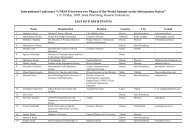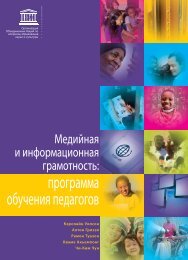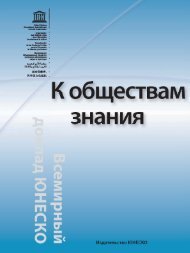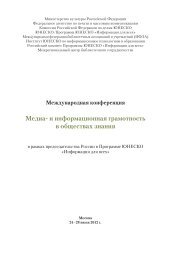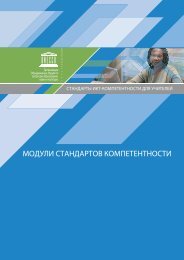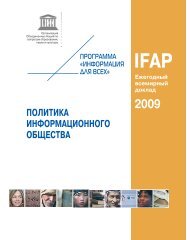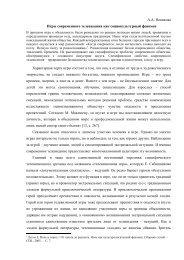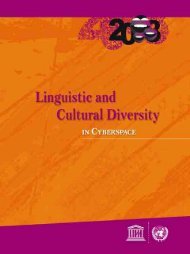Download - РоÑÑийÑкий комиÑÐµÑ ÐÑогÑÐ°Ð¼Ð¼Ñ Ð®ÐÐСÐÐ ...
Download - РоÑÑийÑкий комиÑÐµÑ ÐÑогÑÐ°Ð¼Ð¼Ñ Ð®ÐÐСÐÐ ...
Download - РоÑÑийÑкий комиÑÐµÑ ÐÑогÑÐ°Ð¼Ð¼Ñ Ð®ÐÐСÐÐ ...
Create successful ePaper yourself
Turn your PDF publications into a flip-book with our unique Google optimized e-Paper software.
Promoting the use of a language must take place at every level: educational,<br />
administrative, scientific and technical, even for leisure, and in the regional or<br />
national bodies concerned. It must take place basically at the level of the access<br />
of languages to technology.<br />
Machine Translation<br />
Of all the language technologies, those whose evolution has been followed most<br />
closely are those related to machine translation. As language is perceived to be<br />
what sets the human species apart, the thought that a machine might replace us<br />
– or even go further than us – in the major linguistic and cognitive exercise that<br />
is translation cannot fail to awaken deep-seated fears. And yet, after many years<br />
of failure, we are apparently not so far off the goal … at least, for a few pairs of<br />
privileged languages and still in the field of specialized translation which, we must<br />
recall, concerns between eight and nine of every ten pages translated in the world.<br />
If new public programmes do emerge with the aim of democratizing the<br />
use of machine translation and favouring language pairs that have not been<br />
studied in any depth until now, it is also at the root of competition between<br />
businesses. Thus, the United States administration sees it more as a way of<br />
making businesses more competitive 16 , on the grounds that on average 52 %<br />
of consumers would not buy a product not described in their own language,<br />
according to a study carried out in 2006 in eight developed countries.<br />
However, although everything seems to indicate that machine translation will<br />
be de facto integrated into all our applications, and although the quality seems<br />
to be quite satisfactory for some language pairs and the outlook broader in<br />
terms of the languages concerned, when it comes to most of the pairs treated,<br />
quality is lacking, and in any case concerns barely 60 of the world’s languages.<br />
The geo-linguistic imbalance is clearly visible in machine translation. Although<br />
it is reaching maturity, although it is effective, although it is profitable, it only<br />
concerns very few languages, mostly used in North America and Europe, and to<br />
a lesser extent China and Japan, and the rest of the world is disregarded.<br />
As the most effective systems derive their performance from the corpora<br />
already existing (thanks to “translation memories” and systems that process<br />
statistics) we can see the challenges that persist for languages with small<br />
written corpora.<br />
To return to the Romance languages, although they are suitably equipped 17 ,<br />
developments are still needed to give full satisfaction both to machine<br />
16<br />
See the final paragraph of the document presenting the White House’s Innovation Strategy:<br />
.<br />
17<br />
Namely Catalan, Spanish, French, Italian, Portuguese and Romanian. Galician is finding it hard to find<br />
satisfaction despite various initiatives and the other Romance languages, for different reasons, are far from<br />
being considered suitably equipped to be used in contexts of specialization.<br />
78




